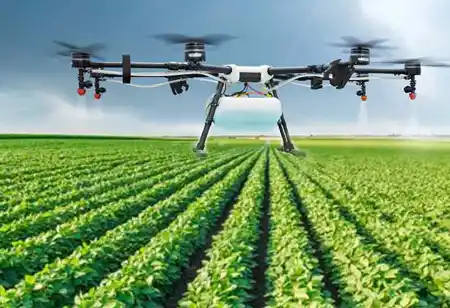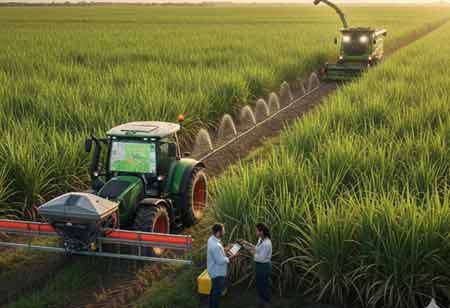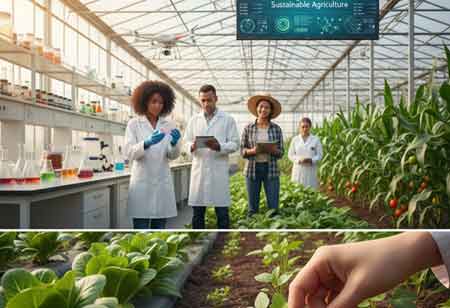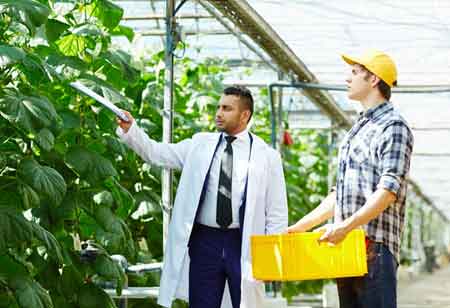Thank you for Subscribing to Agri Business Review Weekly Brief
Agrivoltaics' Dual-Benefit Approach Maximizing Harvest And Energy
While rooftop solar installations have long served farm operations, agrivoltaics presents a revolutionary approach.

By
Agri Business Review | Tuesday, December 19, 2023
Stay ahead of the industry with exclusive feature stories on the top companies, expert insights and the latest news delivered straight to your inbox. Subscribe today.
Agrivoltaics combines solar panels and agriculture on the same land, optimizing energy production and crop yields. Key technologies like MLPE, solar trackers, and bifacial modules are crucial for success.
FREMONT, CA: While rooftop solar installations have long served farm operations, agrivoltaics presents a revolutionary approach. By integrating solar panels with agricultural activities on the same land, this innovative technique holds significant promise for sustainable land use.
Agrivoltaics offers dual benefits, maximising solar energy production while optimising farming productivity. However, its success hinges on careful implementation, leveraging technologies, and detailed design considerations. This emerging field paves the way for a future where food security and clean energy generation coexist.
Maximizing the Harvest:
The critical factor for optimizing energy harvest and crop yields in agrivoltaics lies in module-level power electronics (MLPE), which is vital in maximizing both. By equipping each solar panel with power optimisers, MLPE ensures maximum individual panel performance, irrespective of varying sunlight exposure due to shading or other factors. This translates to maximized energy production and optimal crop yields, as each plant receives the perfect light level for its growth stage.
Sun-Tracking for Efficiency:
AI-powered solar trackers dynamically adjust the tilt of panels throughout the day, closely mimicking the sun's movement and ensuring optimal solar energy capture. This significantly boosts energy production compared to static installations, capturing the maximum amount of sunlight available. In agri-PV systems, trackers ensure that even with panels overhead, crops receive adequate sunlight for healthy growth.
Bifacial Modules:
Bifacial modules boast a unique advantage: generating electricity from both sides. This allows them to capture reflected sunlight from the ground below, effectively increasing energy production. This increases energy output while minimizing the impact of shading on the crops underneath. Bifacial modules are particularly suited for agri-PV systems where maximizing energy yield and minimizing crop shading are crucial for optimal performance.
Integrating Livestock for Sustainable Benefits:
The inclusion of grazing animals can offer several advantages in agri-PV systems. Livestock provide cost-effective vegetation management, reducing the need for herbicides and maintenance. Their presence enhances soil health through natural fertilisation, contributing to a more sustainable ecosystem. However, ensuring the well-being of both animals and crops is crucial. Controlled grazing schedules, appropriate fencing, and careful monitoring are essential for successful implementation.
Supporting Pollinators for Ecosystem Health:
Planting pollinator-friendly species under the solar panels creates valuable habitat for bees, butterflies, and insects. These essential pollinators are crucial in maintaining ecosystem health and ensuring successful crop pollination. Their presence promotes biodiversity and contributes to a more sustainable agricultural ecosystem.
Unlocking the Potential of Agrivoltaics:
Agrivoltaics has the potential to revolutionize food production and energy generation practices. By carefully considering and implementing the appropriate technologies and design strategies, such as MLPE, solar trackers, bifacial modules, sustainable livestock management, and pollinator-supporting plants, agri-PV systems can achieve optimal results. This can increase energy production, maximize crop yields, and a more sustainable and resilient food system.
While these technologies are crucial, several other factors deserve attention. Choosing the correct type of solar module and adjusting their height and spacing is essential for ensuring optimal sunlight exposure for both plants and panels. Additionally, careful soil management practices are crucial for maintaining fertility and preventing erosion. Continuous research and development in these areas will further enhance the effectiveness and sustainability of agri-PV systems.
Agrivoltaics offers a unique opportunity to address the challenges of climate change and resource scarcity while simultaneously boosting food production and clean energy generation. By embracing innovative technologies, careful planning, and a commitment to sustainability, agrivoltaics can transform a more secure and sustainable future for agriculture and energy.
More in News





